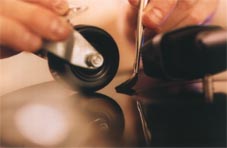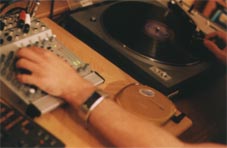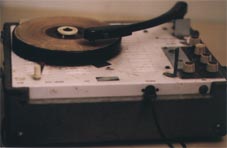
 |
Talking Crosswalks: Nitra, Slovakia |
 |
 |
 |
A CASSETTE OF THIS PROGRAM CAN BE ORDERED FROM THE "ORF
TONBANDDIENST"|
[ Deutsch ] E.O. Sound #1 is a Kunstradio broadcast by artists Tim Jaeger, Civyiu Kkliu, Ilya Monosov, and Josh Russell. The theme is based upon a performance [images] of the same name originating from the Electronic Orphanage in Chinatown, Los Angeles. The original 4-hour performance involved the 3 artists working from a concept that Tim Jaeger devised, but which was, in the spirit of collaboration, taken in a completely different direction. The original concept revolved around the gift economy, and "artistic potlatch", where items (computers, software, records, tables, etc.) are all donated. Surplus/unwanted records to be used as source material were borrowed from popular music stores. E.O. Sound #1's performance was designed to highlight how surplus goods can be used creatively in an economy where there exists disparities between supply and demand. This concept originates in such things as Felix Stadler's Open Source Intelligence. Rather than actually playing and mixing the records, however, the artists physically modified them, destroyed them, used them as materials against which to play objects, or didn't even play them at all. The ensuing recordings were incredibly sparse, with long patches of minimal tones, textures, and eventual breaks into various refrains [original recordings]. E.O. Sound #1 is a broadcast
involving Civyiu Kkliu, Ilya Monosov, and Josh Russell "handling,
playing, and manipulating record players, records, and objects."
Their 22 minute piece is preceded by a 15-minute digital handling
of 'Bargain Bin' material by Tim Jaeger. (Tim Jaeger) The result is the capacity for the physical generation of frequencies and compositional structures most contemporarily arrived at by way of less immediate means. During the live 4 hour EO gallery performance, 11 distinct objects were used individually, and in pairs. The objects included:
This recording7 to be presented by Kunstradio involves 5 of the 11 objects: the coils, the fork, the wheel, the brush, and the metal plate. The latter 3 constitute the majority of the work, and each is found most often registering within, but not restricted to, a specific frequency range. The highest frequencies within this recording are generated by the angling of the metal plate.” Josh Russell: "TECHNICAL: The sounds were created by feeding the headphone out of a mixer board to the first channel input. These were then sampled, and played, and processed, modifying various parameters (duration, volume, cut-off points, etc) in real time. Additionally, another input contained audio coming from a record player, which was sampled through various devices. During the EO event, I experimented with the physical aspects of the records, cutting them in half and taping them back together backwards.” AESTHETIC: I wanted to work such that my sounds never drove the composition, but more just bolstered it by framing with some synthetic sounding textures the rich organic sounds created by Civyiu Kkliu and Ilya Monosov. By working in this way, I was hoping to allow the audience to perceive their organic sounds as fully crafted sound environments, and not just simply “the sounds of wheels and motors.” I further hoped that this method would allow the listeners to disassociate the sounds from the physical objects, and to more easily be immersed in the sounds as sound. In some cases I was trying to make my sounds so that they hang in the background. By this i wanted to dissuade the listeners from perceiving the quietness of moments in the performance as inactive, and to accentuate the silence as dynamic and something that should be actively listened to." Ilya Monosov: "I worked with a violin bow, a metal cymbal, a string (attached to the transcriber) and an old turntable-transcriber. It was important to avoid looking for beauty; you can never find it and besides it's something you must simply notice and be intelligent enough not to ruin ..." [ English ] Diese kollaborative Radioarbeit beruht auf einer Performance der Künstler
in der Electronic Orphanage in Chinatown, Los Angeles. Sie setzten sich
dabei mit der Ökonomie des Überschusses und des Schenkens
auseinander - bezugnehmend auf Phänomene der Open Source Intelligence
von Felix Stadler - und arbeiteten ausschliesslich mit geschenktem /
gespendentem Equipment und Materialien - Hard- und Software, Möblierung,
Schallplatten etc. |